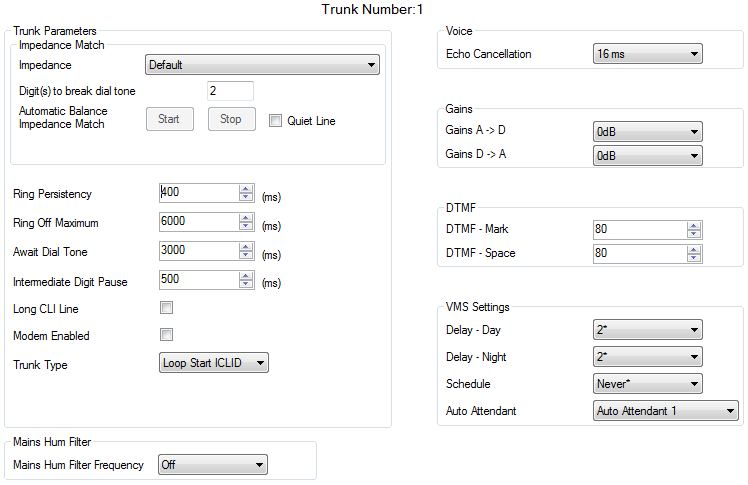This menu is accessed from the System page by selecting Update Trunk Configurations. |
This menu is accessed from the Admin Tasks list by selecting Trunks. |

Trunk Parameters
•Impedance Match
These options are only available for Bahrain, Egypt, Kuwait, Morocco, Oman, Pakistan, Qatar, Saudi Arabia, South Africa, Turkey, United Arab Emirates and United States. For Release 8.0+ they are also available for Canada.
•Impedance: Default = Default
Set the impedance used for the line. The settings vary depending on the system's Country setting.
•Digits to break dial tone: Default = 2. Range = Up to 3 digits.
During impedance testing, once the system has seized a line, it dials this digit or digits to the line. In some cases it may be necessary to use a different digit or digits. For example, if analog trunk go via another PBX system or Centrex, it will be necessary to use the external trunk dialing prefix of the remote system plus another digit, for example 92.
•Automatic Balance Impedance Match:
These controls can be used to test the impedance of a line and to then display the best match resulting from the test. Testing should be performed with the line connected but the phone system otherwise idle. To start testing click Start. The phone system will then send a series of signals to the line and monitor the response, repeating this at each possible impedance setting. Testing can be stopped at any time by clicking Stop. When testing is complete, Manager displays the best match and asks whether that match should be used for the line. If Yes is selected, Manager asks whether the match should be applied to all other analog lines provided by the same analog trunk card or module. To conform with the Receive Objective Loudness Rating at distances greater than 2.7km from the central office, on the analogue trunks a receive gain of 1.5 db needs to be added.
•Quiet Line: Default = Off
This setting may be required to compensate for signal loss on long lines.
•Ring Persistency: Default = 400ms. Range = 0 to 2550ms.
The minimum duration of signal required to be recognized.
•Ring Off Maximum: Default = 6000ms. Range = 0 to 25500ms.
The time before signaling is regarded as ended.
•Await Dial Tone: Default = 3000ms. Range = 0 to 25500ms.
Sets how long the system should wait before dialing out.
•Intermediate Digit Pause: Default = 500ms. Range = 0 to 2550ms.
Pause between digits transmitted to the line.
•Long CLI Line: Default = Off
The CLI signal on some long analog lines can become degraded and is not then correctly detected. If you are sure that CLI is being provided but not detected, selecting this option may resolve the problem.
•Modem Enabled: Default = Off
The first analog trunk can be set to modem operation (V32 with V42 error correction). This allows the trunk to answer incoming modem calls and be used for system maintenance. When on, the trunk can only be used for analog modem calls. The short code *9000* can be used to toggle this setting. For Release 6.1 and higher, the modem feature can be accessed via an auto attendant or DID/SIP URI by selecting 76 as the destination.
•Trunk Type: Default = Loop Start ICLID
Indicates whether the trunk receives incoming caller ID information or not. If caller ID information is not provided, select Loop Start. If caller ID information is received, select Loop Start ICLID.
Mains Hum Filter
•Mains Hum Filter: Default = Off.
If mains hum interference on the lines is detected or suspected, this settings can be used to attempt to remove that interference. The options are Off, 50Hz or 60Hz.
Voice
•Echo Cancellation: Default = 16ms.
Allows settings of Off, 8, 16, 32, 64 and 128 milliseconds. The echo cancellation should only be adjusted as high as required to remove echo problems. Setting it to a higher value than necessary can cause other distortions.
•Echo Reduction: Default = On. (ATM4Uv2 card only)
Used when impedance matching is not required but echo reduction is. Options are On or Off.
Gains
These settings should not be adjusted without guidance from the line provider.
•A -> D: Default = 0dB. Range = -10.0dB to +6.0dB in 0.5dB steps.
Sets the analog to digital gain.
•D -> A: Default = 0dB. Range = -10.0dB to +6.0dB in 0.5dB steps.
Sets the digital to analog gain.
DTMF
•DTMF Mark: Default = 80 (80ms). Range = 0 to 255.
Interval when DTMF signal is kept active during transmission of DTMF signals.
•DTMF Space: Default = 80 (80ms). Range = 0 to 255.
Interval of silence between DTMF signal transmissions.
VMS Settings
•VMS Delay - Day: Default = 2. Range = 0 to 6 (number of rings).
Set the number of rings before an unanswered call should be redirected to an auto attendant when the system is not running in night service mode and the VMS Schedule is set to Always or Days Only.
•VMS Delay - Night: Default = 2. Range = 0 to 6 (number of rings).
Sets the number of rings before an unanswered call should be redirected to an auto attendant when the system is running in night service mode and the VMS Schedule is set to Always or Night Only.
•Schedule: Default = Never.
This option determines when the VMS Delay settings above should be used and unanswered calls redirected to an auto attendant. The options are:
•Always
Redirect calls when the system is in both day and night service modes.
•Day Only
Redirect calls only when the system is not in night service.
•Night Only
Redirect calls only when the system is in night service.
•Never
Do not redirect calls.
•Auto Attendant: Default = Auto Attendant 1. Software Level = 6.1+.
This field allows selection of which auto attendant is used by this line.
